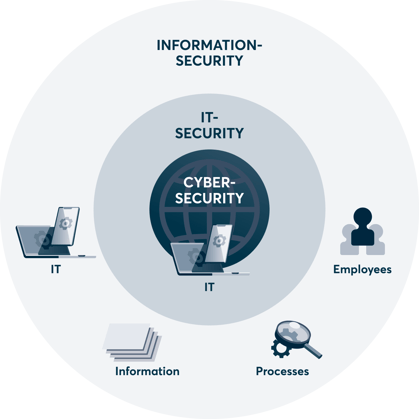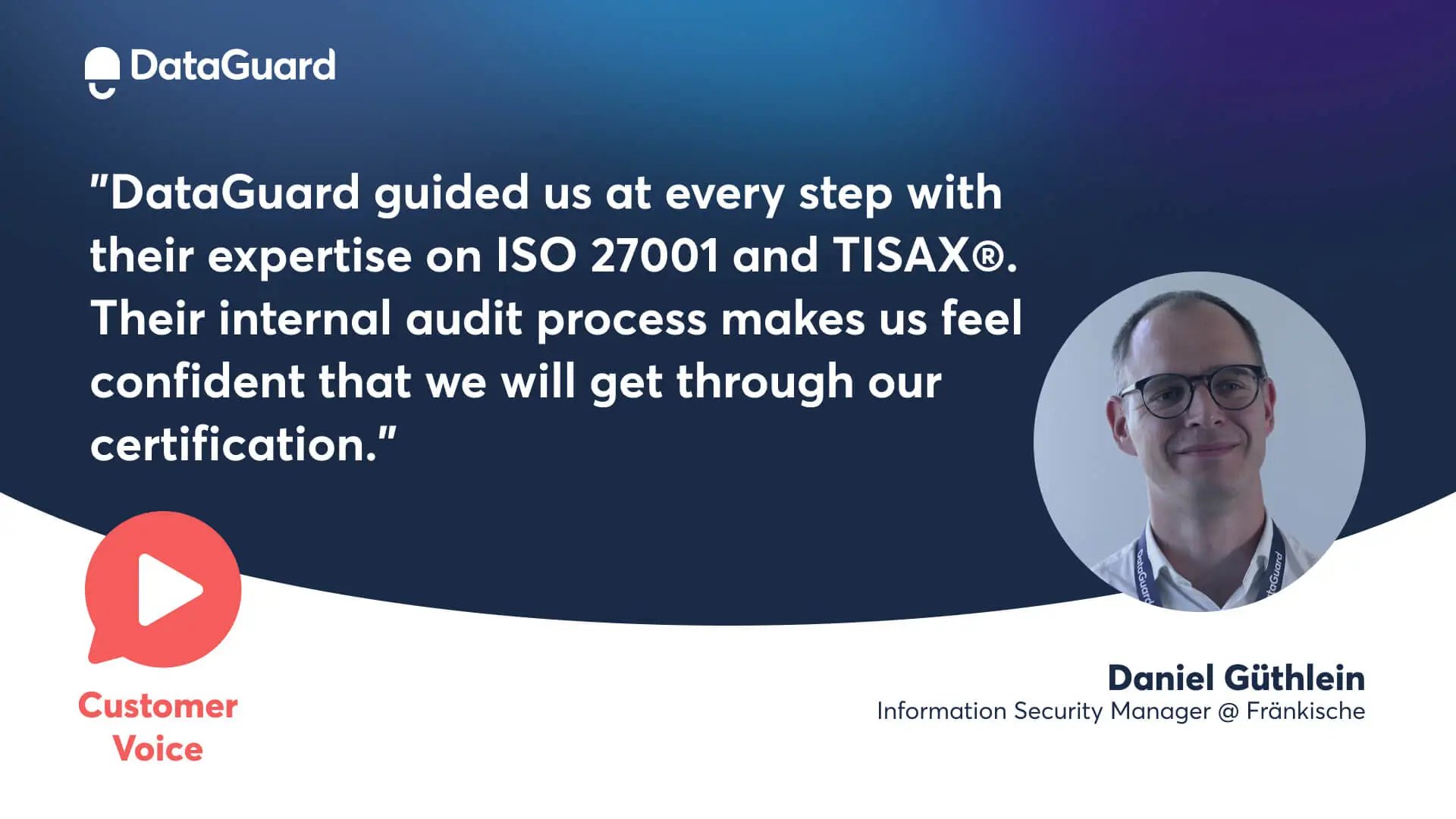Industry-specific certification schemes for information security management systems
Industry-specific certification schemes for information security management systems
ISO 27001 is the gold standard for information security management systems. However, the individual industry, market and national legislation may make other standards relevant.
Take Germany, for instance, where the Federal Office for Information Security (BSI) has developed the standards BSI 200-1 and BSI 200-2. As a 12-step system for implementing a compliant ISMS, is an especially interesting standard to local authorities and small and medium-sized enterprises.
When working with U.S. federal information systems, NIST (National Institute of Standards and Technology) Special Publication 800-53 is the relevant standard – or, with respect to financial reporting, the international Service Organization Control standards SOC 1 and SOC 2.
Accredited ISO 27001 certification
ISO 27001 certification for your company’s ISMS is advisable if you wish or are required to provide proof of your information security to third parties. But the certification isn’t free. Not only do you have to pay for auditing itself, but putting in place the requisite measures can also eat up a good deal of resources. It would, therefore, be aggravating if, for your efforts, you do not successfully pass the certification audit and all you get is a certification that is worth little or, worse, nothing.
There are several national and international accreditation bodies around the world. EU law stipulates that each member state has one national accreditation body – such as the Deutsche Akkreditierungsstelle (DAkkS) in Germany or the Hellenic Accreditation System (ESYD) in Greece.
In the USA, on the other hand, there are multiple accreditation bodies that serve different standards, among them the ANSI National Accreditation Board (ANAB) for ISO 27001 accreditation.
The UK follows the EU model, with one solely appointed national accreditation body, the United Kingdom Accreditation Service (UKAS). Currently, UKAS has accredited more than 150 certification bodies in the UK alone, 24 of which specifically offer accredited ISO 27001 certification.
While UKAS also offers ISO 27001 accreditation to foreign certification bodies as well, certifiers around the world typically pursue recognition by an international accreditation body such as the International Accreditation Board (IAB). Certification bodies accredited by IAB perform audits according to ISO 17021, an international standard for auditing management systems.
Certifications not confirmed by the international accreditation body are often not recognised by business partners. Indeed, most contracts that require ISO 27001 certification mean certification by an accredited body. For this reason, it is strongly recommended that a company pursue certification through an accredited body.
ISO 27001 certification: the costs
For companies seeking ISO 27001 certification, the implementation generally incurs the greatest cost. Meeting the various requirements can take months or even years, and third-party consultant services, often a must, rarely charge daily rates under € 1,500 (£1300).
The certification process itself pales in comparison to the run-up to it. But when it comes to your company’s implementation measures, the proof is in the pudding: if the certification body decides your company falls considerably short of compliance. If you fail the audit, you’ll have to arrange a new audit – the process starts over, and the costs increase.
A medium-sized company with 100 employees and relatively low process complexity per 15 to 20 employees can roughly expect an audit to wrap up in one day. For larger companies, audits will be more time-intensive.
The actual duration will naturally depend on how complex your information security processes are as well as on the scope you’ve defined for your ISMS to cover. Based on our experience, for smaller companies with only one location, certification will run about € 10,000 (£7500). Certification bodies will provide an exact figure upon request.
Recertification: How long is ISO 27001 certification valid?
Putting information security measures in place is not a one-off project but a continuous process. For this reason, your company’s ISMS will need to be recertified from time to time. To stay compliant with ISO 27001, your certification will need to be renewed once every three years through an entirely new audit process. And the certifying body is required to carry out less extensive checks every year. If serious deficiencies are uncovered, certification can be revoked even before the three-year cycle is up. What’s more, ISO 27001 also requires companies to perform annual internal audits independently.
What are the requirements for jobs in information security?
In 2022, there was a global shortage of some 3 million cybersecurity professionals. And it’s no surprise, as the information security job profile brings together a unique skill set – a plurality of competencies that are rare in today’s jobs market, taken even on their own: in addition to a high degree of IT literacy, applicants also need to demonstrate in-depth knowledge of the standards and laws relevant to the field.
Moreover, the job is also one that frequently demands an aptitude for communication and negotiation. After all, information security processes can only work when all the involved company divisions cooperate – getting them to do so is just one more task where the cybersecurity professional must shine.
Information security experts are in high demand in the job market. Previous work experience and knowledge of ISO 27001 and information security management systems are essential for qualification.
Employees should have experience in the following areas:
- Implementation of IT security, including - only if relevant to critical infrastructure (CI) - an understanding of critical infrastructures
- Setting up an ISMS
- Certifying an ISMS in accordance with ISO 27001 / TISAX®
- Managing information security incidents
- Staff training and awareness-raising activities
- Negotiations and project management
(Chief) Information Security Officer: an overview
The CISO, Chief Information Security Officer or Information Security Officer (ISO), is a manager who is responsible for information security in an organisation. They are responsible for the security of information, data, and systems.
The tasks of a CISO are varied and include:
- Developing and implementing cyber security strategies.
- Assessing risks.
- Developing and implementing security measures.
- Monitoring the security situation and training employees in cyber security.
A CISO focuses their attention and efforts on securing the company's interests. The job is something of a balancing act between protecting information assets and ensuring seamless business operations. Normally, the position is directly subordinate to top-level management and works closely with the IT department as well as the compliance and legal teams.
The responsibilities of the CISO include:
- Protecting corporate assets from attacks and data breaches (in cooperation with the Data Protection Officer and IT)
- ISO 27001/27002 and TISAX® certification
- Introduction of an information security management system
- Choosing suitable methods and tools
- Risk management and advising company leadership
- Communication between departments
CISOs are often computer scientists or computer scientist graduates with advanced training or specialisation in the field of information security, in addition to years of experience. The job's responsibilities are not legally defined; a CISO’s day-to-day activities will depend significantly on the company itself and the respective industry. However, there are special cases in the public sector where the job profile is legally defined.
Depending on the company, the position of CISO can be filled by an internal employee or an external service provider.






.png?width=644&height=465&name=Objectives%20of%20information%20security%20(Confidentiality%2c%20Integrity%2c%20Availability).png)





